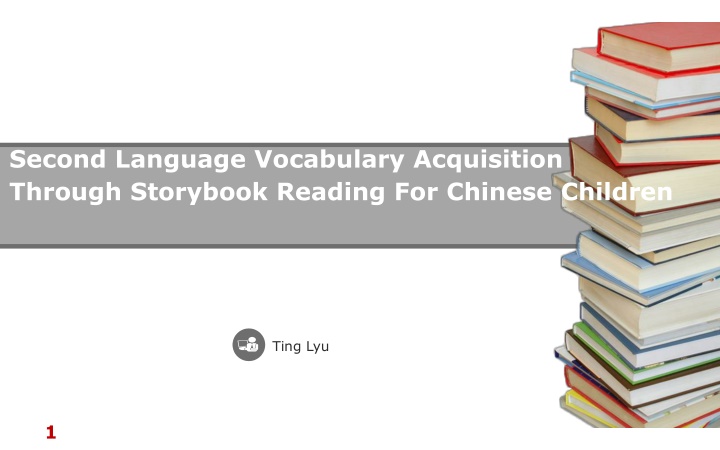
Vocabulary Acquisition through Storybook Reading for Chinese Children
Explore how storybook reading impacts English vocabulary learning in Chinese children, examining research questions, key findings, and methodology. Discover the significance of using storybooks for second language acquisition in China.
Download Presentation

Please find below an Image/Link to download the presentation.
The content on the website is provided AS IS for your information and personal use only. It may not be sold, licensed, or shared on other websites without obtaining consent from the author. If you encounter any issues during the download, it is possible that the publisher has removed the file from their server.
You are allowed to download the files provided on this website for personal or commercial use, subject to the condition that they are used lawfully. All files are the property of their respective owners.
The content on the website is provided AS IS for your information and personal use only. It may not be sold, licensed, or shared on other websites without obtaining consent from the author.
E N D
Presentation Transcript
Second Language Vocabulary Acquisition Through Storybook Reading For Chinese Children Ting Lyu 1
Contents Contents 1 Research Questions and Significance 2 Key Findings from Literature Reviewed 3 Participants, Instrumentation and Procedure 4 Data Analysis 5 Findings 6 Implications for Practice 7 Suggestions for Further Research and Limitations 2
Research Questions RQ1 Does English storybook reading help children learn English vocabulary? RQ2 Is prior English vocabulary level a significant predictor of post-intervention vocabulary level? RQ3 Does method of instruction impact post-intervention vocabulary level, after controlling for prior English vocabulary level? RQ4 Does the impact of method of instruction on post-intervention vocabulary level depend upon the student's initial English vocabulary level? Significance It expands the knowledge base regarding the use of storybook reading for second language learning in China. 3
Key Findings from Literature Reviewed For Monolinguals For ELLs Research Gap 1. Storybook reading helps ELLs learn English vocabulary. 1. Children learn more words by more exposures to the same storybooks. 1. insufficient studies on the storybook reading supported with primary language in the classroom setting. 2. Children s initial vocabulary knowledge has an impact on the vocabulary learning 2. Explanation of words or content before, during and after reading is effective in facilitating vocabulary acquisition. 2. Conflicting results as to the influence of initial vocabulary level. 3. Readers should choose different reading styles based on children's language level. 3. Scarce studies conducted in the non- English enviroment for young children 4. Detailed explanation help children learn more words. 4
Procedure Participants Preparation: selection of books & words The subjects were 5-6 year old Chinese children in a bilingual kindergarten, from Shanghai, China. Pilot Study: test intrument Main Study: Preview- review concurrent Instrumentation Pre-test 24 words 24 words Researcher-developed Target Vocabulary Test (TVT), which includes items from three stories. Intervention 20 minutes *3 times* 3 stories 20 minutes*3 times * 3 stories The test for each story contains six target words and two general words in the story. Post-test 8 words * 3 stories 8 words * 3 stories 24 items in the test 5
Data Analysis Main Analyses Preliminary Analyses Participants Age p=.93 (t test) RQ1 Two separate dependent-samples t-tests Prior Vocab. Level t test p=.91 RQ2 Two simple linear regressions of posttest scores on pretest scores for each group Gender 2 p= .78 RQ3 Sequential multiple linear regression Instrument Reliability (Pearson) r=.73 RQ4 Sequential multiple linear regression Validity (t test) p<.01 Statistical assumptions influence, distance, and leverage 6
Findings RQ1 There is evidence to suggest that English storybook reading does help children learn English vocabulary RQ2 Prior English vocabulary is a significant predictor of post-intervention vocabulary level for both groups RQ3 The method of instruction had a large effect on the post intervention vocabulary. Children in the concurrent translation condition score higher on the posttest than those in the preview-review condition, after controlling for the pretest performance RQ4 There is insufficient evidence to suggest that the impact of method of instruction on post-intervention vocabulary level depends on the students initial English vocabulary level 7
Implications for Practice Implications for Practice Researchers Teachers & Parents Policymakers adjust the kindergarten curriculum to incorporate English storybook reading into the classroom teaching This study provides some of the first empirical evidence of using storybook reading to teach young ELLs in China. Rich explanations of words. use English and Chinese interchangeably in reading The concurrent translation method is more effective than the preview-review method development of children's primary language 8
Suggestions for Further Research and Suggestions for Further Research and Limitations Limitations Further Research Limitations A larger sample size and more kindergartens construct validity mono-method bias measure additional elements of English knowledge The selection of words in the instrument was not based on precise empirical data examine whether the level of primary language affects the outcomes internal validity experimenter effect randomized experimental study or gather data on children's backgrounds and initial language proficiency levels independent replications train classroom teachers to provide the intervention external validity only one kindergarten was studied the long-term effects of storybook readings 9
10 The End
